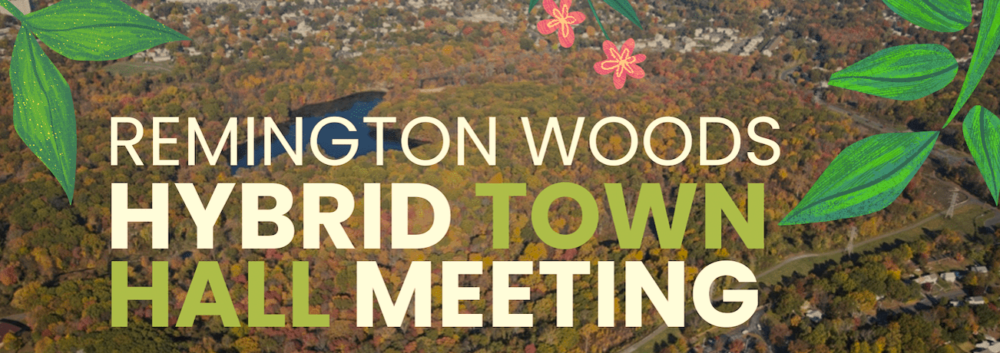Multiple Pathways (and Obstacles) to Conserving Remington Woods
By Grace Arpie
Remington Woods, a 422-acre forest in Bridgeport and Stratford that has been off-limits to the public for decades due to extensive environmental contamination, was the subject of a hybrid town hall meeting hosted by the Connecticut Chapter of the Sierra Club on Friday, October 28th, at Housatonic Community College in Bridgeport. The area has been fenced off for decades as it was used as a munitions testing ground for the Bridgeport-based Remington Arms Company from 1906 to 1989.
Since 1990, when the EPA provided the current property owner, Corteva, a Legal Consent Order (LCO), requiring environmental remediation, what the Woods will be used for when remediation is complete has been an ongoing debate. That debate has only been heating up again in the past year, as Corteva is nearing completion of their extensive remediation work. It is estimated that $75-100 million has been spent to date by Corteva on remediating the site.
Last year this area, distinctive as the largest intact forest in Bridgeport, was the subject of an extensive rezoning plan in Bridgeport that ultimately changed the zoning of the Woods from “light industrial” to “residential office center”, despite an outcry from residents and activists in favor of designating the site as open space for residents to access. Earlier this year, Stratford’s Zoning Commission rejected a proposed zoning amendment to allow multifamily housing on either side of Broadbridge Avenue, which also would have affected Stratford’s portion of the woods.

An overhead view of Remington Woods, with Broadbridge Ave in the foreground. The forest spans 422 acres—347 in Bridgeport and 75 in Stratford. (Photo credit: Corteva)
At the October 28th meeting, graduate students Walker Cammack and Kaley Casenhiser of the Yale School of the Environment presented “Conservation Pathways for Remington Woods”, based on a longer report that was prepared for Groundwork Bridgeport, a non-profit organization whose mission is to empower “people, businesses, and organizations to promote environmental, economic, and social well-being.”
While many have called for the Woods to be preserved and opened to the public for passive recreation such as hiking and walking after remediation is complete, the extensive contamination presents some obstacles.
Cammack and Casenhiser pointed out that the Legal Consent Order issued by the EPA only requires Corteva to remediate up to Industrial/Commercial standards; a higher standard of remediation would need to be completed in order to open the Woods for access to the public as well as to designate it as open space. This would not only be costly financially, but ecologically, as more soil and vegetation would need to be removed and would potentially cause disruption to the immediate neighborhoods surrounding the forest.
It is estimated that to remediate Remington Woods up to a Residential standard (the standard that would make the woods safe for full public access/open space) could cost an additional $30 million, and the disruptive impacts of further remediation would need to be studied in more depth.

Lake Success, a 23-acre lake in the heart of Remington Woods. (Photo credit: Corteva)
However, other pathways to preservation of the Woods exist. Cammack and Casenhiser discussed other options: development on previously disturbed areas, with preservation of the remaining undeveloped forest; full preservation of the property, with no public access; full preservation with partial public access; full preservation of the woods, with public access (the costliest option financially as well as ecologically).
While it is not decided how development or conservation will proceed at Remington Woods, public sentiment leans in favor of conservation with at least some public access, as evidenced by last year’s zoning meetings in Bridgeport.
Attendees at the October 28th informational meeting shared their connections to the woods, their hopes for conservation, and discussed possible uses for the forest, such as an outdoor nature classroom for Bridgeport schoolchildren. One attendee also pointed out that the history of the forest begins much further back in time than 1906, the year Remington Arms acquired the property—it’s a possibility that Native American archaeological sites, such as camps and burial grounds, exist there.
Although the path forward is not yet clear, one thing is— Remington Woods has been supporting humans and wildlife for far longer than its most recent, destructive history would suggest, and area residents want to reclaim this forest as their own.
Further reading & references:
https://www.saveremingtonwoods.org/
https://www.groundworkbridgeport.org/
https://www.ctpost.com/news/article/Bridgeport-OKs-some-development-at-Remington-Woods-16667114.php
https://www.ctpost.com/news/article/Remington-Woods-future-dependent-on-Bridgeport-16536707.php
https://www.ctpost.com/news/article/Stratford-rejects-Broadbridge-Avenue-multi-family-17085502.php


I zoomed in on the meeting, and what was most obvious, from the very thorough presentation, was the extreme complexity of moving forward to preserve and open the woods to the public, even partially. It will take cooperation among numerous supporting groups to achieve the financial and tactical means to do that. Truly a very steep mountain to climb. I know that there are many passionate enthusiasts, but leadership is needed to enable any progress.